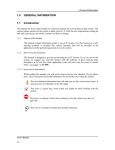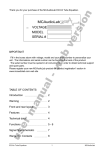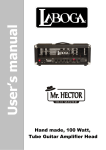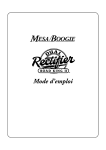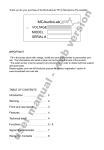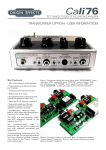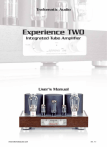Download Yamamoto A08-S Amplifier User Manual - JAC
Transcript
Yamamoto A08-S Amplifier Kit August 24th 2009 b www.jacmusic.com Horber Steige 25 * 72172 Sulz * Germany * Tel: ++49-1755382641 First we must say, for legal reasons it is not possible that our company JACMUSIC writes an official manual for other companies products. However we answer often technical questions about the A08-S, so we intend this document to be used only additional to what is officially supplied by the YAMAMOTO SOUNDCRAFT COMPANY OF JAPAN. An earlier version of this amplifier was called A08. This newer version is called A08-S, where the S stands for the DC current meter, and lower hum of the output signal, and replacement of the 5U4G tube with the Type 80 tube. The A08-S is supplied by the factory as pictured above, with 8 Ohms output. A special version can be ordered, such as amplifiers designed for Western Electric 205D tubes, or a 16 Ohms output. Materials used The wood is cherry, which is beautiful looking by itself, but not very suitable to construct a tube amplifier directly. So before use, the wood is specially treated by Yamamoto, called the Shashih process. This process significantly increases the hardness, and in this way, the thread of the screws can be cut directly in the wood, even for very small screws like 3mm, this works excellent. Also the Copyright by: www.jacmusic.com * Horber Steige 25 * 72172 Sulz * Germany * Tel: ++49-1755382641 Copying of this document is not allowed, also not partially, and also not for private publication in the internet. In case of copyright violation, we have the right to take legal action without notice. Shashi process will give very good electrical isolation to the wood, and electrical components can be mounted directly on the wood from the inside. It can be observed with tube amplifiers, having wooden parts, those develop a crack after several years, or thick piano lacquer starts to crack, or chip off. This is caused by the internal heat of tube amplifiers, and frustration can be very high if this happens after some years. However with Shashi treated wood, this will never happen. Long term stability of Shashi is excellent, and the extra costs are a good investment. The feet of the amplifier are of Ebony wood, and are in line with the Yamamoto philosophy of using Ebony stands for Audio Equipment. Some classical instruments like oboe, and the neck of a guitar are made from Ebony as well. The transformer cap is of brushed aluminium, cherry colour anodized. Tubes supplied The amplifier is supplied by Yamamoto with following tubes: 2x Type 45. 2x 717A 1x Type 80 rectifier. These are used tubes, but well tested by the Yamamoto company, care is taken that these are also optically fine tubes. Tubes replacement Great care must be taken that the tubes for your A08-S are in good condition, since best sound can only come this way. Saving money on tubes is the worst you can do, when good sound is what you want. However buying triple selected tubes from obscure specialists is often a waist of money. So buy good tubes from people that use good equipment, and make no secret about how they test tubes. A non-documented tube test may be good, but a documented tube test may is more professional. Here is some information on the particular tubes: Tubes position Believe it or not, but it is a classical mistake to put a rectifier in the 45 socket, or also put in a 45 or the 80 rectifier with the pins in the wrong position. Do not orient the tubes position by the printing on the tube! There is no relation. Always check the tubes pins first. The 717A, if it will not fit in, do NOT force it. Check if you have the guide pin at the right position. Type 45 tubes. We recommend you, not to use any Chinese 45. The recommended 45 tube from new production is the Emission Labs 45 or 45 mesh. The mesh tubes may have best sound if you prefer the high transparency that most horn speakers have, the solid plates are closer in sound to historical tubes. However such audible differences are small. Copyright by: www.jacmusic.com * Horber Steige 25 * 72172 Sulz * Germany * Tel: ++49-1755382641 Copying of this document is not allowed, also not partially, and also not for private publication in the internet. In case of copyright violation, we have the right to take legal action without notice. With RCA 245 tubes With EML 45 tubes From historical production all 45 can be used when they have sufficient emission. This can be seen from the plate current on the meter, it must be approximately 32mA, and not drop at high loudness. End-of-Life with 45 tubes. It is hard to say with only the amplifier at hand, if this point has been reached. Weak tubes will give at first a less quality sound, a more fuzzy sound, and loose dynamics.This can be heard by experienced listeners, but is hard to describe here. The tubes can be in that condition for some time, and/or start to loose Bias on the meter already at that moment, or later. Allways, what you should do, before starting to use an 45 tubes, write down the initial value on the base of the tube, with a sticker. Later, if you want to know if a tube has lost emission, it is very good to compare with that initial value. Of course, the absolute value is also imporant, but most important is a change from the initial value, because only the CHANGE will indicate something. Note, that some lowering of the bias current is normal when the tubes get older, and is not allways a bad sign. So absolute values can not be given here. Example: A new tube gives 35mA and after a long time you see it starts to drop, and will go down steadily to a value like 29mA. So some part of the life time has been used up. How much that is, can not be said. However if new tubes give 29mA they have full 100% lifetime ahead of them. So, the main function of the meter is to write down the initial value for each tube, and compare with that later. The number itself is less important unless it gets very low, or unless is drops at high sound levels. Any problems with sound disappearing for 0.5 seconds after a tone with high loudness, means the 45 tubes are at the end of life definitely. Tube burn in. This is necessary with new 45 tubes, and also with used tubes that have been stored for more than 2 years. Though normal function will appear, the initial sound is harsh and unpleasant sometimes. Just use the tubes normally for a period of 50…100 hours and good sound will develop surprizingly at the end of the burn in period. 717A tubes. These are in the family of the famous Western Electric 408A tube, though not the same tube. Because of the metal shielded sides, 717A is very suited for HiFi. With 717A there are many used and weak tubes for sale, and we can only say, never buy those from people who can not tell you if the tubes are good, have no microphonic, and no crack noise. Also NOS tubes come out of the boxes “weak” sometimes from too long storage. It appears these can not be recovered to good condition if so. However such 717A that appear to be good, will stay so for many years longer. The only way to test 717A is on a tube tester giving results in Mili Ampere. Any “Good/bad” scale testers can not test this tube well. Always be sure that if you buy them, there has been a microphonics test done as well. Last warning is for auctions, there are many so called new tubes, that are sold with very low test values. Copyright by: www.jacmusic.com * Horber Steige 25 * 72172 Sulz * Germany * Tel: ++49-1755382641 Copying of this document is not allowed, also not partially, and also not for private publication in the internet. In case of copyright violation, we have the right to take legal action without notice. Type 80 rectifier. A bad rectifier will result in lower plate current, visible on the meter. However a rectifier that will supply enough stand-by current may still be not good, since the amplifier circuit is auto bias, and very good quality, new 45 tubes can compensate that for some part. So they will still run close to 32mA, but plate voltage is too low. Obviously best sound can not result this way. So make sure you have at least one known to be really unused, NOS Type 80 rectifier, and compare any unknown rectifiers with this. So compare the meter readings, and compare the dynamics of the sound at high volume. With some experience, you can easily pick out a weak rectifier like this. Unfortunately unused (NOS) Type 80 and 717A are getting scarce now, but good tubes will serve a long time. Note: Testing of rectifiers can not be done very reliable on a Hickok tester, though this is the mostly used tester for USA tubes. So readings on a Hickok must be very strong, to be sure. Best tube tester for the 80 are the AVO's (Mk2 or higher) or the Russian L3. Service, Repairs and technical issues. This should only be done by a qualified high voltage technician. There are no parts inside that need service or adjustment, though it is always a good idea with anybrand tube amplifier to check it from the inside latest after 10 years. Do a careful visual inspection of all components, and re-tighten all screws moderately so good ground connections are still present. It is amazing to see sometimes that tube amplifiers are constructed such that this is impossible. Not so with the A08-S! The bottom cover of the A08-S is one single piece, and when it is removed, all parts can be very conveniently reached even from the sides, for service or repairs. Though perhaps not important when new, your service technician will be satisfied to see how convenient it is, to work an the A08-S. Transformer caps: The transformer caps need never be removed, also not for checking up. However if you whish to do so, do not remove the screws that you see from the outside. For removal of the cap, take off the amplifier bottom, and then from the inside remove the four large black screws. This will remove the whole cap unit with just four screws. Before you do, mark the back of the cap. If you forget this, you might put back on the cap reversed, and the screws may not fit. Copyright by: www.jacmusic.com * Horber Steige 25 * 72172 Sulz * Germany * Tel: ++49-1755382641 Copying of this document is not allowed, also not partially, and also not for private publication in the internet. In case of copyright violation, we have the right to take legal action without notice. Fuse replacement. Do not just replace a blown fuse if you do not know why it blew out. It is important to know the reason. The fuse holder is a small drawer above the mains connector. Pull out that drawer and you’ll see two fuses. One is a spare fuse, one is the fuse used. The fuse used is the one that goes in deepest. If the blown out fuse is broken into glass pieces, you made a very bad short circuit, like put in a tube in the wrong position. After replacing the fuse, look at the white switch lamp when switching on. If it lights only very short, the fuse blew out again, and in this case the amplifier needs to be repaired. Switch on: . The A08-S may only be switched on with the Speakers connected and with the inputs connected, and all tubes inserted. (Exception 717A tubes, read next part below). When switching on, observe if the meter reaches approximately 32mA for both channels. Otherwise, switch off and clear this first. Do not experiment if the 45 tubes bias not at expected. It is normal if there is some overshoot of the Bias current immediately after switch on, for 0.5 to 1 second. After this bias must move towards the final value. When switching on, observe if the meter reaches approximately 32mA for both channels. If much higher or much lower, switch off and clear this first. Do not experiment if the 45 tubes bias is not at expected. Copyright by: www.jacmusic.com * Horber Steige 25 * 72172 Sulz * Germany * Tel: ++49-1755382641 Copying of this document is not allowed, also not partially, and also not for private publication in the internet. In case of copyright violation, we have the right to take legal action without notice. Humming sound. This can come from the amplifier, from the tubes, or from other sources. You may use the A08-S only with the inputs connected to a pre-amp, and the pre-amp must be switched on. Otherwise hum may appear. If hum still appears, in some cases hum is caused by so called ground loops. These are very hard to identify, and you may have no clue where it comes from, and accuse the wrong parts of the equipment. A simple way to find this out with the A08-S, is to remove the 717A tubes while the amplifier is OFF. Then switch on without the 717A. If the hum is gone now, you have a ground loop very likely, and the hum is not caused by the amplifier. The best solution is, use Lundahl LL6810-PHMPHM interconnect cables, and the problem is gone. LL6810-PHMPHM has two male RCA connectors, but versions from XLR to RCA exist also. Recommended speakers Yamamoto YS-500, Yamamoto YS-604. Sensitivity needed 98dB or more. Notes for Avantgarde Speakers: Though several of these can be 16 Ohms, these will work very good on the 8 Ohms Version A08-S. If there is any hum issue, read the above section about ground loops, you may need the Lundahl interconnect cable, from the pre-amp to the A08-S. Specifications: Output Power: 2x 2Watt Frequency characteristic: 18-30kHz (at 1Watt) Input impedance: 200k ohms External Dimensions: : 400(W) x 294(D) x 204(H) Weight: 14.3 kg Telefunken RGN1064 Mesh rectifier in A08-S. This is the tweak #1 from JACMUSIC Copyright by: www.jacmusic.com * Horber Steige 25 * 72172 Sulz * Germany * Tel: ++49-1755382641 Copying of this document is not allowed, also not partially, and also not for private publication in the internet. In case of copyright violation, we have the right to take legal action without notice.








